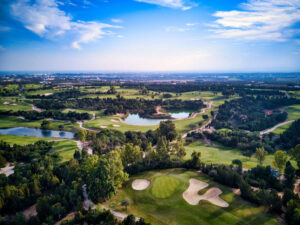An unusual combination at first glance, but, dig a little deeper and you’ll find Tunisia has everything you need for a golf break in the sun. This North African country, sandwiched between Algeria and Libya, is not among the world’s best known golf destinations but it boasts 10 courses and is reachable within a 3hour flight from mainland Europe. There is a wealth of history, some of the hotels are top notch and service levels are genuinely high.

On top of that, everything is relatively inexpensive, and that includes golf. But what about the courses? There are 10 golf courses in Tunisia and a couple more in the pipeline. Most are situated in the main coastal tourist areas, ready to attract those seeking some golf while enjoying the typically warm climate, great beaches and some very good hotels.
The good news is that most were designed by American designer Ron Fream whose company Golf plan was involved in the development of Tunisian golf from the 1970s.This means there are some great designs, some very challenging, others more suited to holiday golf.
In recent times, its golf the Tunisian Tourism authorities have been keen to promote. F or golfers living in northern Europe, Tunisia is the ideal place for a winter golf break. Playing golf amongst the camels and overlooking clear blue ocean provides a break from cold, windy and wet conditions or even courses closed because of snow.
Most of Tunisia’s 10 golf courses are situated by the Mediterranean in the popular Tourist resorts of Port El Kantaoui, Monastir and Hammamet. When one flies into Tunis-Carthage Airport, is spending a day or two in the Capital Tunis, why not visit the country’s oldest golf course, Golf de Carthage, at La Soukra. Built in 1927, this is one of Africa’s oldest courses. Today, it’s a little scruffy but still a charming place to enjoy a morning round. The fairways wind between 100-year-old eucalyptus trees and olive groves and there is plenty of tree trouble. A surprising feature of the club is that at night, the clubhouse bar doubles as a disco, complete with DJ and turntables playing the European dance music.
The two courses at Port El Kantaoui are more likely to attract the serious golfer. Six miles north of Sousse, the country’s third largest city and a favourite of the British, Port El Kantaoui was built in 1979 and soon after saw the development of two 18-hole courses under American architect Ronald Fream. The Panorama course is regarded as its Championship course while the Sea Course is a gentler alternative. The European Tour used to make a regular stop in Tunisia with El Kantaoui as the preferred venue. The club employs a rotation policy, allowing higher and lower handicaps to play a different course each day, speeding up play and sharing the quality holes fairly. The Panorama is called that for a good reason. It has the better views, like that from the elevated tee at the 555m 18th hole, down towards the Mediterranean Sea, which could distract you from the drive over the Olive trees. At Palm Links at Monastir, some 90-minutes from Hammamet, you’ll find Tunisia’s answer to links golf. Close to Sousse, this reclaimed marshland is now a likeable quirky course set next to a racetrack.
The best golf though, is to be found at Golf Citrus at Hammamet, around an hour from Tunis. This 36-hole golf complex was superbly run and its marshals had golfers hitting tee-times the way soldiers about turn on the drill square. Its two courses, Les Oliviers and La Foret, are tough by any standards. Next door to Citrus Golf is the Yasmine Golf Course, a gentler proposition with twin lakes and frequently tiered greens. The Marshal here arrived in a buggy at the 9th and presented my playing partner and I with a flask of English Breakfast tea, and a selection of Arab cakes, a demonstration of hospitality not unusual at Tunisia’s golf courses.
After a 17-year absence, top-flight golf returned to Tunisia as the Port El Kantaoui Golf Club played host to the Tunisian Seniors Open, a brand-new event on the European Seniors Tour. Contested by the leading 60 players from the European Seniors Tour exemption category list. The event represented the first major tournament to take place in the country since the mid 1980’s when for three years the Port El Kantaoui course hosted the Tunisian Open, a major European Tour event. A number of the current European Seniors Tour line-up contested the event, including Tommy Horton MBE, Christy O’Connor Jnr and the 1982 Champion Antonio Garrido. Created in 1991, the European Seniors Tour has grown rapidly in stature over the course of the past decade, and now boasts a schedule of 20 events with a prize fund totalling some 4.5 million euros.

